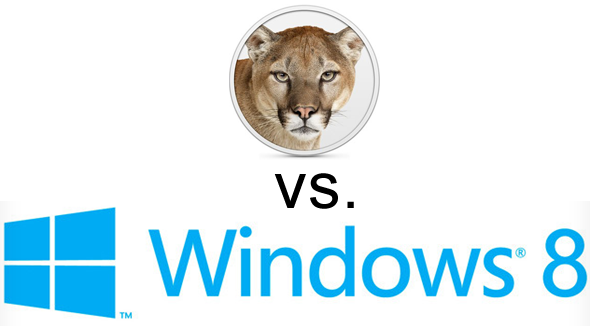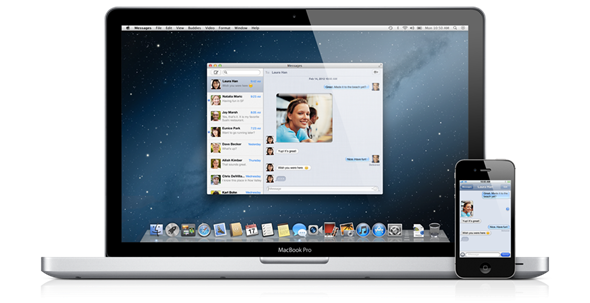Following Apple’s announcement of its upcoming Mountain Lion OS yesterday, people naturally began producing comparisons between the two OSes, whether in the form of a jestful "Windows 8 vs. ML" tweet, or a clarifying blog post that reminds you – since you didn’t know – that desktop OSes are beginning to draw a great deal of inspiration from their mobile counterparts. But really, that’s about the only true similarity between Mountain Lion and Windows 8. Beyond this, Apple and Microsoft’s approaches are so vastly different that the colossal void that lies between the opposing directions they have taken is large enough to accommodate all of those comparison posts from yesterday. So, let me commence this actually sensible comparison between the two approaches to the desktop and tablet markets.
Microsoft has approached the tablet space by making radical changes to Windows, so it may cater to both PCs and laptops as well as ARM tablets (Windows on ARM is what Windows 8’s ARM alter ego is referred to.) "Metro-style", full screen apps have been introduced that are set to be entirely touch-optimized, with a Windows “app” Store to boot. They’ve replaced the Start Menu with something called a "Start Screen", which is basically a highly touch-optimized, tile-based UI where you can launch desktop as well as the new Metro apps. You can use gestures to bring up the "Charms" bar, which offers both system-wide settings as well as app-specific settings that you may wish to have at hand (such as volume control).

What they are doing now is, essentially, a far more drastically executed version of the school of thought that they have always maintained: Tablets are simply another PC form factor, and they don’t justify the creation of a separate OS. In the past, Microsoft never seemed to understand touch gestures. Tablet PCs, and even more recently, touch gestures in Windows 7 is pitiful. I could go on about handwriting support, but I’d either fall asleep or be too distracted at how horribly adapted legacy Windows software is to touch-based gestures.
However, while the "one-OS-fits-all" school of thought is continued, Microsoft have made a complete 180-degree turn from its former execution. Sure, they’re developing one OS for both desktops and tablets, but again, colossal changes have been made to greatly improve the touch experience. Apps will be built specifically for touch. Also: It’s worth noting that, on ARM tablets, the Windows 8 "legacy" desktop will be highly restricted to running only the software and functionality bundled in Windows, and Microsoft Office (which, they claim is "highly architected" to touch.) That’s it.
It’s a far riskier approach to what Apple is doing. iOS is an already tested and thoroughly received OS/user experience. The same cannot be said of Metro, so it’s hard to say at this point how consumers will react to the changes.
Apple approached the mobile space by creating a separate, specialized OS for mobile users. iOS was initially designed from the ground up specifically for touch, with no legacy software or functionality on either the mobile phone or tablet form factors. The third-party apps that Apple eventually did begin to serve as a platform were also designed from the ground up specifically for touch. The only tie that iOS had to the PC during much of its short lifespan was for the purpose of syncing/backup, but that cord was cut when Apple launched iCloud.

Yes, Apple desired to grant iOS distinct separation from its desktop computers, but that’s because in their vision and strategy, they believe that the mobile and desktop have fundamental differences that warrant this "independence". That being said, this "independence" isn’t violated or contradicted by Apple drawing inspiration from iOS. The "independence" by definition is in place as Apple truly believes that a true "convergence" of platforms into one OS – à la Windows 8 – is the wrong approach. Following iOS’ success, there was this colossal user base that was highly familiar with iOS, and Apple saw that – when implemented correctly – touch is a very intuitive method of interaction.

Thus, beginning with Lion, they implemented certain touch-based gestures and functionality. However, instead of the means of interaction being an actual touchscreen that requires stretching your arms out across your desk, they did so through the Magic Mouse and Magic Trackpad (this is something I’d like to see Microsoft doing; implementing touch mouse/track pad gestures and highly advocating its use). We see the continuation of iOS features being brought to the desktop with Mountain Lion. Despite this, it’s important to remember that the independence between iOS and OS X remains. This distinction is what makes Apple’s strategy totally unique from Microsoft; yes, OS X may draw functionality and, in the case of Mountain Lion, some core apps from iOS, but this is really as far as they will go (i.e don’t expect a Mountain Lion iPad to be announced on March 7th).
This comparison is quite like the frequent Mac vs. PC argument (where people often mean Mac vs. Windows). You cannot compare an entire hardware + OS ecosystem with an OS licensed to other manufacturers. You can, however, compare the different approaches.
To quote John Gruber, who I believe also understands the fundamental difference between Apple and Microsoft’s mobile strategies:
Apple sees a fundamental difference between software for the keyboard-and-mouse-pointer Mac and that for the touchscreen iPad. Mountain Lion is not a step towards a single OS that powers both the Mac and iPad, but rather another in a series of steps toward defining a set of shared concepts, styles, and principles between two fundamentally distinct OSes.
For discussion on this topic: Check out the threads on Facebook or Google+.
You can follow us on Twitter, add us to your circle on Google+ or like our Facebook page to keep yourself updated on all the latest from Microsoft, Google, Apple and the web.

